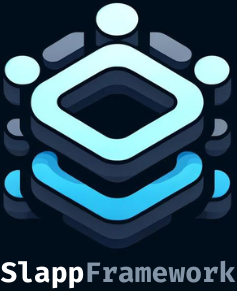
_Lovers
_Application
_Framework
Quick Start (3 Steps)
1. Install the template:
dotnet new install SlappFramework.Template2. Create your project:
dotnet new slappframework -n MyDataApp3. Configure and scaffold:
- Update
appsettings.jsonwith your SQL Server connection - Execute
SqlScripts/CreateBulkOpsInfrastructure.sql - Run
EXEC ZZ_SlappFramework.ScaffoldAn_INSERT_Feature @DomainTableName='Products'
That's it! Run your app and features appear in the menu automatically.
✨ What You Get
Six data operations scaffolded out-of-the-box:
- insertViaForm - Single-record form entry
- insertViaExcel - Download template → Edit offline → Upload
- insertViaHandsontable - Excel-like grid editing (inline)
- updateViaForm - Edit single records
- updateViaExcel - Select rows → Download → Edit → Upload
- updateViaHandsontable - Bulk edit in grid
All workflows include:
- Automatic constraint validation (your staging table = your validator)
- Foreign key dropdown support
- Rich error messages
- Transaction-based processing
- Excel import/export with FK dropdown sheets
"Data as valid as your staging table, GUARANTEED!"
SlappFramework is a constraint-driven, SQL-centric web framework for building bulk data management interfaces. Your database constraints are your validators - no validation code needed.
📦 First Release Available
SlappFramework is now available as a .NET project template! Install it and start building data management apps in minutes.
🎯 The Core Concept
- Bulk data operations should be first-class citizens. Importing via Excel should be supported as well as entering data via a web form, for example.
- Data constraints/validation rules should not have to be duplicated, ANYWHERE!
Instead of writing validation code in C# and/or js, design proper table constraints once. SlappFramework bulk-copies your data to staging tables, SQL Server enforces constraints, and the framework collects detailed error messages. Only valid data proceeds to your domain tables.
CREATE TABLE dbo.Products (
ProductName NVARCHAR(100) NOT NULL,
Price DECIMAL(10,2) CHECK (Price > 0),
CategoryID INT NOT NULL
FOREIGN KEY REFERENCES dbo.Categories(CategoryID),
-- Scaffolding generates a staging table to enforce ALL of this automatically
)Result: Zero validation code. Data as valid as your staging table. Guaranteed.
🏗️ Built For
- SQL Lovers - Developers who prefer SQL programming and want to leverage database capabilities fully
- Enterprise Apps - Internal business applications requiring bulk data management
- Rapid Development - Teams wanting to avoid months of grid/Excel integration work
- Constraint-Driven Design - Projects where the database schema is the source of truth
💡 Commercial Licensing: SlappFramework uses Handsontable and EPPlus, which require commercial licenses for production use (~$1,200-1,400/developer/year). View full licensing details →
🔧 Technology Stack
Backend: .NET 8.0, C# 12, SQL Server 2019+, Dapper, SqlBulkCopy, EPPlus, CSVHelper
Frontend: ASP.NET Core, Bootstrap 5, Handsontable, AG-Grid, Select2
Distribution: NuGet project template
SlappFramework is functional and ready for evaluation.
Feedback and bug reports are welcome!
https://github.com/ChrisHamiltonSystems/SlappFramework-Feedback/issues
© Chris Hamilton. All Rights Reserved. | Licenses & Attribution